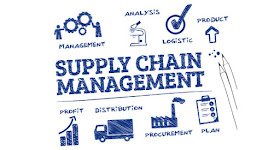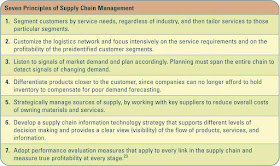CHAPTER 10 MGT 300
Chapter 10 Extending the Organization – Supply Chain Management

Supply Chain Management
v The average company spends nearly half of every dollar that it earns on production
v In the past, companies focused primarily on manufacturing and quality improvements to influence their supply chains
Basics of Supply Chain
v The supply chain has three main links:
Ø Materials flow from suppliers and their “upstream” suppliers at all levels
Ø Transformation of materials into semi-finished and finished products through the organization’s own production process
Ø Distribution of products to customers and their “downstream” customers at all levels
v Organizations must embrace technologies that can effectively manage supply chains
v Plan
Ø A company must have a plan for managing all the resources that go toward meeting customer demand for products or services.
v Source
Ø Companies must carefully choose reliable suppliers that will deliver goods and services required for making products.
v Make
Ø This is the step where companies manufacture their products or services. This can include scheduling the activities necessary for production, testing, packaging, and preparing for delivery.
v Deliver (Logistic)
Ø Companies must be able to receive orders from customers, fulfill the orders via a network of warehouses, pick transportation companies to deliver the products, and implement a billing and invoicing system to facilitate payments.
v Return
Ø This is typically the most problematic step in the supply chain. Companies must create a network for receiving defective and excess products and support customers who have problems with delivered products.
Information Technology’s Role in the Supply Chain
Factors Driving SCM
Visibility
v Visibility – more visible models of different ways to do things in the supply chain have emerged. High visibility in the supply chain is changing industries, as Wal-Mart demonstrated
v Supply chain visibility – the ability to view all areas up and down the supply chain
v Bullwhip effect – occurs when distorted product demand information passes from one entity to the next throughout the supply chain
v Supply chain visibility allows organizations to eliminate the bullwhip effect
Ø To explain the bullwhip effect to your students discuss a product that demand does not change, such as diapers. The need for diapers is constant, it does not increase at Christmas or in the summer, diapers are in demand all year long. The number of newborn babies determines diaper demand, and that number is constant.
Ø Retailers order diapers from distributors when their inventory level falls below a certain level, they might order a few extra just to be safe
Ø Distributors order diapers from manufacturers when their inventory level falls below a certain level, they might order a few extra just to be safe
Ø Manufacturers order diapers from suppliers when their inventory level falls below a certain level, they might order a few extra just to be safe
Ø Eventually the one or two extra boxes ordered from a few retailers become several thousand boxes for the manufacturer. This is the bullwhip effect, a small ripple at one end makes a large wave at the other end of the whip.
Consumer Behavior
v Companies can respond faster and more effectively to consumer demands through supply chain enhances
v Once an organization understands customer demand and its effect on the supply chain it can begin to estimate the impact that its supply chain will have on its customers and ultimately the organizations performance
v Demand planning software – generates demand forecasts using statistical tools and forecasting techniques
Competition
v Supply chain planning (SCP) software– uses advanced mathematical algorithms to improve the flow and efficiency of the supply chain
v Supply chain execution (SCE) software – automates the different steps and stages of the supply chain
v SCP and SCE both increase a company’s ability to compete
v SCP depends entirely on information for its accuracy
v SCE can be as simple as electronically routing orders from a manufacturer to a supplier
v Competition
v SCP and SCE in the supply chain
Speed
v Three factors fostering speed
v Supply Chain Management
Success Factors
Success Factors
v SCM industry best practices include:
Ø Make the sale to suppliers
Ø Wean employees off traditional business practices
Ø Ensure the SCM system supports the organizational goals
Ø Deploy in incremental phases and measure and communicate success
Ø Be future oriented
v SCM Success Stories
v Top reasons why more and more executives are turning to SCM to manage their extended enterprises
v Numerous decision support systems (DSSs) are being built to assist decision makers in the design and operation of integrated supply chains
v DSSs allow managers to examine performance and relationships over the supply chain and among:
Ø Suppliers
Ø Manufacturers
Ø Distributors
Ø Other factors that optimize supply chain performance
SUPPLY CHAIN MANAGEMENT Success Stories
























.jpg)









